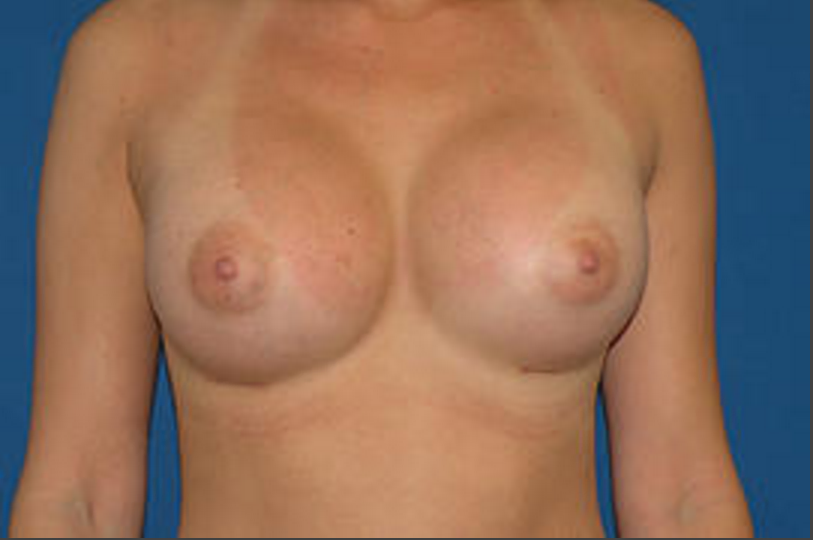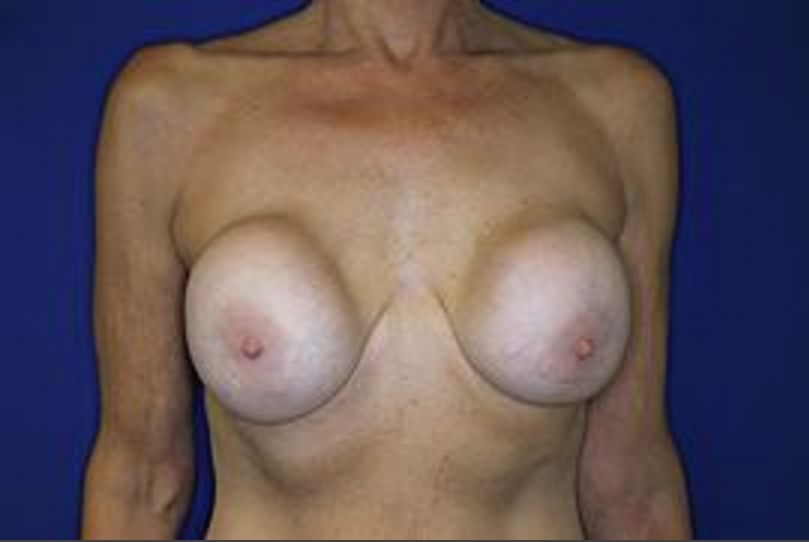BEST BREAST IMPLANT REVISION SURGEON IN THE USA
- View Dr Diaz’s Before & After results!
- Learn more about Capsular Contracture and how you can have the breasts you always wanted again.
- Dr. Diaz is one of the most sought after Surgeons in the USA. He is the past president of the Los Angeles Society Of Plastic Surgeons, as well as a diamond member of Allergan, placing him in the top 3% of all Surgeons in the country.
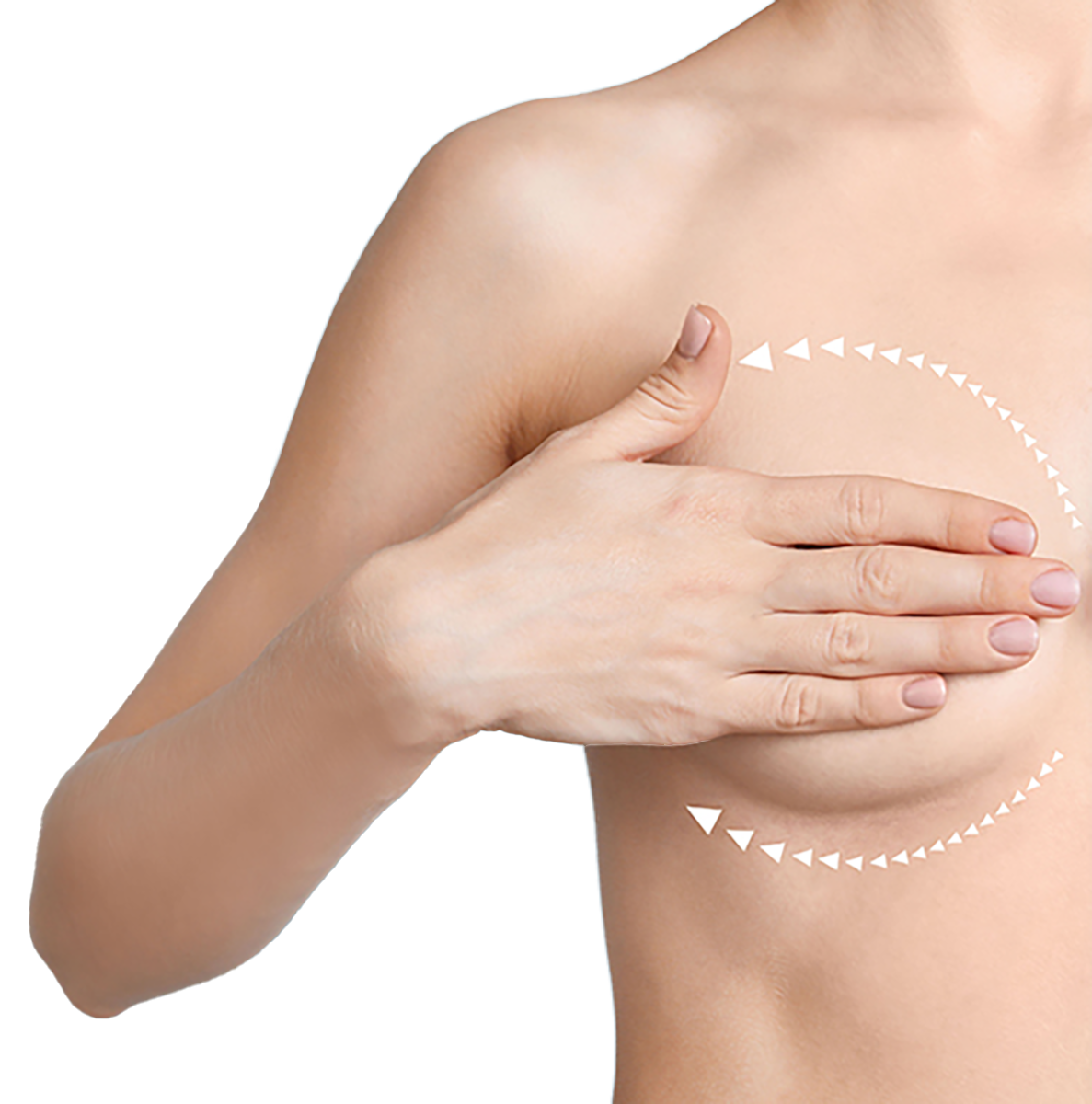
Allergan Diamond Status
Top 3% Of Plastic Surgeons In The Nation.
Google / Yelp / RealSelf
4.9 Star Rating / 515 Reviews
Highest Antibacterial Standards
One of the lowest rates of infection after surgery in the world.
1,000s Of Surgerys
One of the lowest rates of infection after surgery in the world.
Alpha Omega Alpha Award
Top 10% Of Medical Students In The Nation
Patients seek Dr. Diaz for revision surgery in the USA because of his incredible results and impeccable reputation with breast augmentation. This has allowed him to develop extensive experience with revision surgery of the breast. As a result, he has perfected techniques to correct capsular contracture, size asymmetry, shape asymmetry, and other issues of the breast requiring revision.
A consultation with Dr. John Diaz is unlike any other. Dr. Diaz spends an entire hour with you during the consultation explaining every detail of the operation and answering all of your questions. He also utilizes 3 dimensional imaging to show you what your results will look like. There is simply no other breast revision consultation in the USA that can match the experience you will have with Dr. Diaz
Capsular Contracture Is One Of The Most Common Reasons To Need Breast Revision
Capsular contracture is a frustrating and disappointing problem. Often, when capsular contracture occurs, it causes other problems with the breasts, such as pain, asymmetry in size, asymmetry in shape and unsightly scarring or healing. Fortunately there are numerous options available to help correct it. Some of these options don’t involve surgery. However, surgical correction will be needed when non invasive treatments don’t work.
In this website, I review all of the available information about capsular contracture. I also review all of the available non surgical treatments. There are also videos of the surgery and before and after photos of patients.
Capsular Contracture Surgery Types & Procedures Involved:
If non surgical treatments of capsular contracture are unsuccessful, surgery will be required. The exact surgical procedure, or set of procedures, needed to correct capsular contracture will depend on how severe the contracture is. In general, the more severe the contracture is, the more likely it will be to require multiple steps to fully correct it. These steps may or may not include removal of the implants, replacement of the implants, capsulotomy, capsulectomy, changing of implant pocket, application of acellular dermal matric and possible breast reshaping.
- CAPSULOTOMY
- CAPSULECTOMY
- CHANGE OF IMPLANT POCKET
- INSERTION OF NEW IMPLANTS
- APPLICATION OF ACELLULAR DERMAL MATRIX (ADM) OR SURGICAL SILL SCAFFOLD (SERI)
- BREAST RESHAPING
What can happen to implants because of capsular contracture:
| Ruptured Silicone Implant
Due to capsular contracture. |
Creased Silicone Implant
Caused by pressure from capsular contracture at approximately 11 O’clock. |
There are numerous surgical options to treat capsular contracture. More severe capsular contracture requires a combination of techniques to achieve the best result. These include removal of the affected implants, capsulotomy, capsulectomy, insertion of new implants, application of ADM or SERI and breast reshaping. The exact technique, or combination of techniques needed can be determined only after a thorough consultation has been completed.
WHAT IS CAPSULAR CONTRACTURE?
When anything is placed in the tissues of the human body, a very thin layer of scar tissue forms around it. This is true whether it is an artificial hip or a breast implant that is inserted. The scar tissue wraps around the implant like a bag. Normally, the scar tissue is very thin and almost transparent. You wouldn’t even know it is there. That is why it is normally not a problem. However, for reasons that are not well understood, the scar tissue can gradually, or suddenly, become thicker and firmer. As the scar tissue thickens and firms, it tightens around the implant. The normally soft feeling implant then becomes firm to the touch. When this happens, it is called Capsular Contracture. If the scar tissue tightens more, it squeezes on the implant causing it to appear very round and “high.” If the scar worsens, there may even be pain.
This is an example of a severe case of capsular contracture (In the left breast).
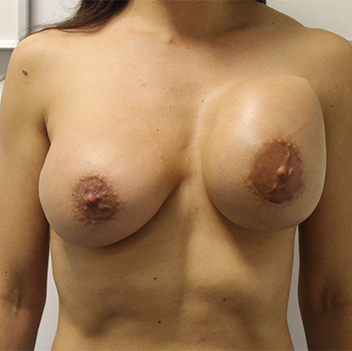 |
Unfortunately, Capsular Contracture is the most common complication associated with breast augmentation. The percent chance of it occuring varies greatly. In some cases, it can be as low as 1% or as high as 20%. Also, capsular contracure can happen at any time. Some patients develop it years after their surgery.
Dr. Diaz’s rate of capsular contracture has been studied and is 1%, which is the lowest rate observed. |
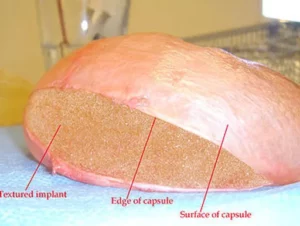 |
The capsule is made of a combination of scar tissue and other cells. The scar tissue is composed of abnormally organized collagen fibers. There may also be cells, called myofibroblasts, present. Myofibroblasts can contract, similar to muscle cells, and cause the tightening and shrinking of the capsule. The breast may not change very much in appearance in mild cases of capsular contracure. These mild cases may respond to non surgical treatments to correct it. However, if capsular contracture progresses, it can cause distortion of the breast shape and even pain. Once capsular contracture is advanced, only surgical treatments will be successful at correction. |
 |
This is a photo of a thin capsule around an implant. This is a photo of an implant after it was removed from a severely thickened and hardened capsule. Note how much smaller the capsule is. This created severe tightening of the implant and resulted in distortion of the patient’s breast shape. |
WHAT CAUSES CAPSULAR CONTRACTURE?
AND WHAT CAN BE DONE TO PREVENT IT
Unfortunately, there is no one single explanation or cause of capsular contracture. In fact, despite numerous detailed studies, capsular contracture remains poorly understood. However, all of the scientific research done over the past several decades has shed some light on capsular contracture and there are some theories to help explain why it sometimes happens. It is important to remember, as one reviews these theories, that many cases of capsular contracture can happen without any apparent cause.
EXCESSIVE BLOOD IN THE BREAST POCKET
One possible cause of capsular contracture is the presence of excess blood in the breast pocket. This usually occurs during the initial surgery. If there is an excessive amount of bleeding, or the blood that collects in the breast pocket is not removed or cleaned out prior to inserting the implant, this excess blood can stimulate the inflammatory process that leads to capsular contracture.
Capsular contracture may also be caused by a hematoma. A hematoma is a collection of blood that forms after surgery. When it occurs, the breast becomes very swollen and painful. Once this happens, surgery is required to remove the blood. Studies show an increased risk of capsular contracure if someone develops a hematoma after breast surgery.
These are pictures of Dr. Diaz’s technique. When the finger is removed, you can see there is no blood whatsoever on the glove. The breast pocket is meticulously dissected and there is no bleeding present.
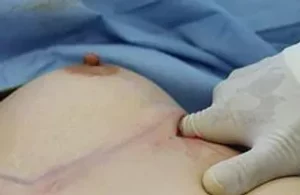
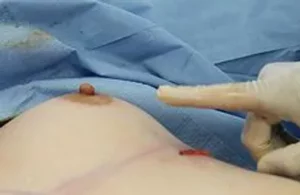
If someone develops capsular contracture, it does not mean that they must have had excess bleeding or a hematoma. Capsular contracture is sometimes caused by unknown reasons. This is just one theory, of many, that may explain some cases of capsular contracture.
Dr. Diaz prevents bleeding during breast surgery through his careful and meticulous operative technique. You can see this in the pictures above. You can also click on his video at the bottom of this page to see how carefully he performs a breast augmentation.
PRESENCE OF BACTERIA IN BREAST POCKET OR ON THE BREAST IMPLANT
There are many studies which show that the presence of bacteria on the implant or in the breast can cause capsular contracture. The presence of even a few bacterial cells (which would not cause any infection) may lead to an inflammatory process that results in capsular contracture. This is called a “subclinical” infection because the amount of bacteria involved is so small (“sub”) that there will not be an infection visible (“clinical”). The theory is that these few cells of bacteria in the breast pocket and on the implant produce a thin film of molecules on the implant surface called a “biofilm”. The biofilm may be responsible for setting off the process that leads to capsular contracture.
There are many things Dr. Diaz does to prevent the chance of bacteria contaminating the breast pocket or breast implant during surgery. One thing is to use an inframammary incision (under the breast). This incision avoids the nipple and areola, as well as the underarm area, which are areas that are normally covered and filled with a large amount of bacteria.
Another stratgey Dr. Diaz uses to prevent bacteria from contaminating the implant is to wash the breast skin very carefully at the start of the surgery and again right before he inserts the implant. The antibiotic solution is dark in color. This step ensures that the skin in the area is as sterile as possible.
Dr. Diaz also washes his gloves thoroughly with an antibiotic solution before handling the implant. This ensures there is no contamination of his gloves.

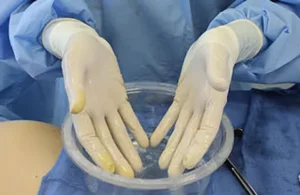
Lastly, Dr. Diaz uses a “No Touch” technique to insert the implant. This means he does not touch the implant during the surgery, therefore keeping it perfectly sterile. After opening the implant package, the implant is carefully placed inside a Keller Funnel. The Keller Funnel is then used to insert the implant into the breast.
This is a picture of the implant package immediately after it has been opened. / This picture shows the implant being immediately placed into the Keller Funnel. These steps prevent contamination of the implant.
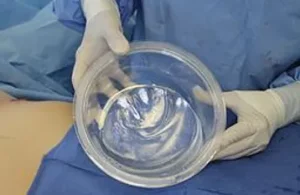
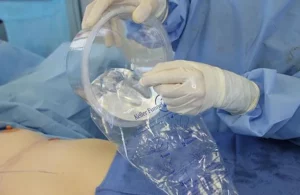
Very few surgeons take as many steps as Dr. Diaz does to prevent capsular contracture. This is why he has one of the lowest rates of capsular contracture of any surgeon in the world.
This picture shows Dr. Diaz inserting the implant using the Keller Funnel. / This shows the breast immediately after the implant is inserted.
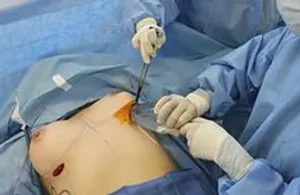

It is important to remember that capsular contracture may also occur for unknown reasons. It does not mean that the person must have had bacterial contamination. This is just one theory as to why it may occur.
MICROSCOPIC CONTAMINATION OF BREAST POCKET
Another theory is that contamination of the implant, or of the breast, with very small or microscopic particles can lead to capsular contracure. These particles may be particles in the air, or fibers from the drapes, towels and sponges used during surgery. The presence of these particles may stimulate an inflammatory reaction in the breast which may ultimately lead to capsular contracture.
Dr. Diaz prevents contamination of the implant and of the breast by employing the numerous special techniques described above.
Just because a patient develops capsular contracture, it does not mean that there must have been contamination of the breast or implant. Capsular contracture is also caused by unknown reasons.
INJURY TO MUSCLE AND BREAST TISSUES
Another theory is that rough handling of the breast tissues and/or muscle may lead to capsular contracure. If the dissection is not meticulously performed, there could be unintentional injury to the muscle or the breast tissue. Most of the time, this minor “bruising” does not result in capsular contracture or other complications. However, it is possible that it can lead to inflammation which can stimulate the formation of capsular contracture.
If someone develops capsular contracture, it does not mean that their tissues must have been handled roughly. Capsular contracture can also happen for unknown reasons.
OTHER THEORIES
Many patients will ask if capsular contracture was caused by their body “rejecting” the implant. This does not happen. There is no evidence of an immune system reaction to the implant. There is also no evidence of the body “rejecting” the implant. This is a misconception.
The silicone in a breast implant is an “inert” material. This means that the body does not form an immune reaction to it. Capsular contracture represents an inflammatory process, not an immune system reaction.
Complications after breast surgery, such as the need to remove the implant, can occur. However, this is caused by things such as excess bleeding, infection or severe capsular contracture. It is not a result of the body’s immune system “rejecting” the implant.
Capsular contracture remains a poorly understood complication after breast surgery. There are several theories as to what can cause it. These include excess blood in the breast pocket, the presence of bacteria in the breast or on the implant, contamination of the breast or implant with microscopic particles and rough handling of the breast tissues and muscle.
Patients can develop capsular contracture even when there is no evidence of bleeding, bacteria, contamination or rough handling of tissues. Therefore, there may be, as of yet, unknown reasons why capsular contracure may occur.
Symptoms & Diagnosis Of Capsular Contracture
Capsular contracure is diagnosed based on the symptoms and the physical exam. Firmness of the breasts which has worsened over time is a sign of capsular contracture. Once capsular contracture is diagnosed, it is classified into a grade. The most commonly used system is the Baker Classification of Capsular Contracture. This classification system is summarized below.
BAKER GRADE 1There is no palpable capsule. The breast feels as soft as an unoperated one. This is normal and no treatment is necessary.
|
BAKER GRADE 2There is minimal firmness. The breast is less soft, and the implant can be palpated. May improve with breast massages and/or medications.
|
BAKER GRADE 3There is moderate firmness. The breast is harder, the implant can be easily felt, the implant can be easily seen and the breast shape is mildly distorted. Surgery is usually necessary. |
BAKER GRADE 4This is severe contracture. The breast is hard, tender to the touch, painful and may feel cold. The breast shape is markedly distorted. Surgery is necessary to correct this.
|
About Dr. John Diaz
Dr. John Diaz is an Ivy League graduate from Cornell University. He received a scholarship to attend the prestigious Albert Einstein College of Medicine in New York. Dr. Diaz graduated medical school with the highest honors and for this he received the Alpha Omega Alpha Award, which is given to only the top 10% of medical students in the country.
He completed his training in Plastic and Reconstructive Surgery in N.Y.C. where he had the privilege of working alongside some of the most famous plastic surgeons in the world. Dr. Diaz is a published author of articles on plastic surgery. He received a degree with Distinction in Plastic Surgery Research for his work.
He has received awards from the New York Regional Society of Plastic Surgery, Montefiore Medical Center and the Albert Einstein College of Medicine. Dr. Diaz is a medical staff member of the renowned Cedars Sinai Medical Center in Los Angeles, CA and has a private practice in Beverly Hills. He is the Past President of the Los Angeles Society of Plastic Surgeons and has presented lectures on plastic surgery throughout the United States.
He has been featured as a plastic surgery expert on a variety of television programs including CNN, Dr. Drew’s Lifechangers, and HLN, to name a few.
Dr. John Diaz is a board certified plastic surgeon in Beverly Hills, CA
![]()
![]()
![]()



![]()

PATIENT REVIEWS
ALMOST 20 YEARS OF EXPERIENCE. THOUSANDS OF HAPPY PATIENTS.
HUNDREDS OF FIVE STAR REVIEWS.
HIGHEST OVERALL RATED PLASTIC SURGEON IN LOS ANGELES
Media
DR. JOHN DIAZ IS ONE OF THE TOP PLASTIC SURGEONS IN LOS ANGELES.

LA Magazine just recognized Dr. John Diaz as one of the best plastic surgeons in Beverly Hills and Los Angeles. He has also published a book entitled Comprehensive Guide to Breast Augmentation.
DR. DIAZ ON INSTAGRAM
Frequently Asked Questions
How much does Dr John Diaz, Beverly Hills plastic surgeon charge for breast revision?
Dr John Diaz, MD, Beverly Hills premiere plastic surgeon charges on average between $10,000 & $50,000 for breast revision surgery. This estimate covers everything you will pay from start to finish, including all fees, anesthesia, any necessary medical tests, and post-operative visits. Dr Diaz is one of the leading plastic surgeons in the world. If you are looking for the best, contact his office to schedule a consultation and find out what your breast revision surgery cost would be.
Related Readings:
Is breast revision more expensive?
In many cases, breast revision surgery can be more expensive than the initial breast augmentation or reconstruction because it may require additional time, expertise, and resources to address specific issues or complications from previous surgeries.
It’s essential to consult with your plastic surgeon and discuss the details of your case to get a clear understanding of the anticipated costs. Ask each doctor you see what their specific pricing is for some of the major cost factors listed below:
- Surgeon’s fees: This includes the surgeon’s skill, experience, and reputation.
- Facility fees: Costs associated with the surgical facility or hospital where the procedure takes place.
- Anesthesia fees: Charges for the anesthesia administered during the surgery.
- Medical tests and imaging: Pre-operative tests and imaging studies that may be required.
- Implant costs: If new implants are needed, their cost will contribute to the overall expense.
- Post-operative care: Follow-up appointments and any additional care required during the recovery process.
Related Readings:
Is a breast revision more painful?
In some cases, a breast revision may involve less pain than the initial breast surgery, if it is a minor adjustment or correction. The pain experienced during a breast revision surgery can vary from person to person though, and it depends on several factors such as the extent of the revision, the individual’s pain tolerance, and their overall health.
Keep in mind that pain is subjective, and while some individuals may report more discomfort with revision surgeries, others may find the experience less painful. Each person’s experience is unique, so it’s crucial to discuss your expectations and concerns with your surgeon before the procedure. Your surgeon will be able to give you more accurate expectations, taking into account the level of pain you experienced during the initial breast augmentation.
Related Readings:
How much does a breast implant revision cost on average in California?
On average, breast implant revision costs $8,200 based on calculations done by CareCredit averaging patient reviews from RealSelf [1]. The cost of a breast implant revision surgery can vary widely based on several factors, including the specific nature of the revision, geographical location, the surgeon’s experience, and past results. Based on research from the top ranking breast revision surgeons in California and nationwide, breast revision surgeries can range from $4,000 to as high as $75,000. These estimate covers the surgeon’s fees, anesthesia, facility fees, and any necessary medical tests or post-operative garments.
It’s essential to consider additional potential costs, such as pre-operative consultations, post-operative follow-up visits, and prescription medications.
To obtain an accurate and personalized cost estimate, it’s recommended to schedule a consultation with a board-certified plastic surgeon.
Related Readings:
Sources:
[1] https://www.carecredit.com/well-u/health-wellness/breast-implant-revision-cost/
What is a pocket revision in breast surgery?
A pocket revision in the context of breast surgery typically refers to a surgical procedure that involves modifying or adjusting the pocket in which a breast implant is placed. The implant pocket is the space created during the initial breast augmentation surgery to accommodate the implant. There are different types of implant pockets, including submuscular (beneath the chest muscle) and subglandular (between the chest muscle and breast tissue).
Related Readings:
What is considered a revision surgery?
A revision surgery, in a broad sense, refers to any surgical procedure performed to modify or correct the results of a previous surgery. It encompasses a variety of procedures across different medical specialties. In the context of plastic or cosmetic surgery, including breast surgery, facelifts, rhinoplasty, or body contouring, a revision surgery typically involves making adjustments or improvements to the initial surgical outcome.
Related Readings:
How long do I have to sleep elevated after breast revision?
Typically, the initial period of sleeping with an elevated upper body lasts for the first few days to a couple of weeks post-surgery. Here are some general guidelines:
- First Few Days: Immediately after breast revision surgery, your surgeon may recommend sleeping with your upper body elevated, especially during the initial days. This helps minimize swelling, promotes proper drainage, and reduces discomfort.
- First Week to Two Weeks: In many cases, surgeons advise patients to continue sleeping with their upper body elevated for the first week to two weeks following surgery. This period may vary based on the extent of the revision and individual healing progress.
- Individual Variation: The specific duration of sleeping elevated may vary among patients. Some individuals may be advised to continue the elevated sleeping position for a shorter or longer duration based on their unique circumstances.
The duration for sleeping elevated after breast revision surgery can vary based on individual factors and the specific recommendations provided by your surgeon.
Related Readings:
What are the main risks of breast revision surgery?
Some risks associated with revision surgery include: (These and more should be discussed with your doctor)
- Infection
- Bleeding
- Anesthesia Risks
- Changes in Sensation or Numbness
- Unsatisfactory Results
- Implant-related Complications
- Wound Healing Issues
- Allergic Reactions
The specific risks can vary depending on the nature of the revision, the patient’s health, and other factors. As always, you should consult with each doctor you see, while you are deciding who you want to perform your revision surgery, and ask about all of the potential risks involved.
Related Readings:
What is a breast revision?
Breast revision refers to a surgical procedure performed to modify or correct the results of a previous breast surgery, such as breast augmentation, reduction, or reconstruction. The primary goal of breast revision surgery is to address issues related to the initial procedure or to make desired changes to the breasts. Common reasons for breast revision include:
- Complications from Previous Surgery: Addressing complications such as implant malposition, capsular contracture (scar tissue tightening around implants), implant rupture, or other issues that may arise after the initial breast surgery.
- Change in Implant Size or Type: Some individuals may choose to alter the size or type of breast implants for reasons such as personal preference, lifestyle changes, or changes in aesthetic goals.
- Correction of Asymmetry: Adjusting breast symmetry to create a more balanced and proportionate appearance.
- Addressing Changes Over Time: Modifications may be desired to address changes in breast appearance due to factors like aging, weight fluctuations, or pregnancy.
- Improving Aesthetic Outcome: Enhancing the aesthetic results of the initial surgery, including refining breast shape, position, or overall appearance.
- Resolution of Discomfort or Pain: Correcting issues that may cause discomfort or pain following the initial breast surgery.
Related Readings:



